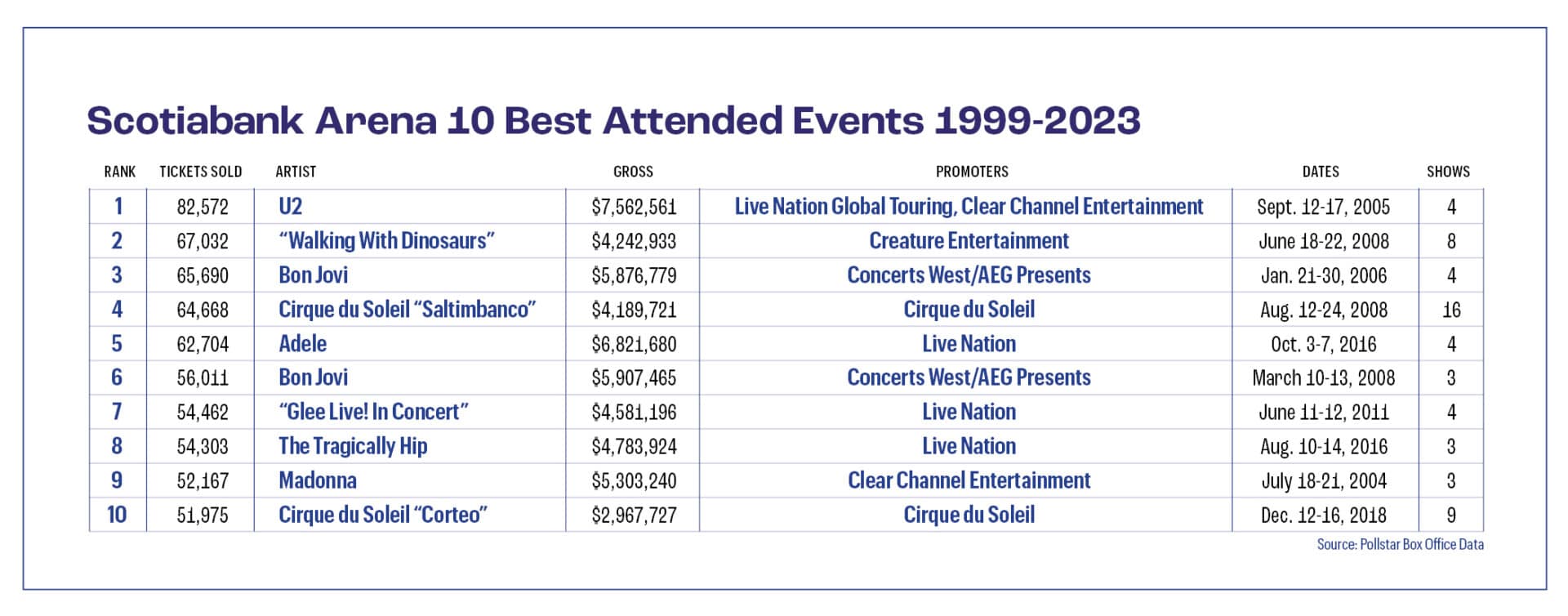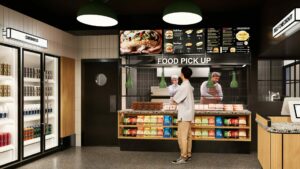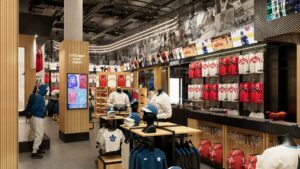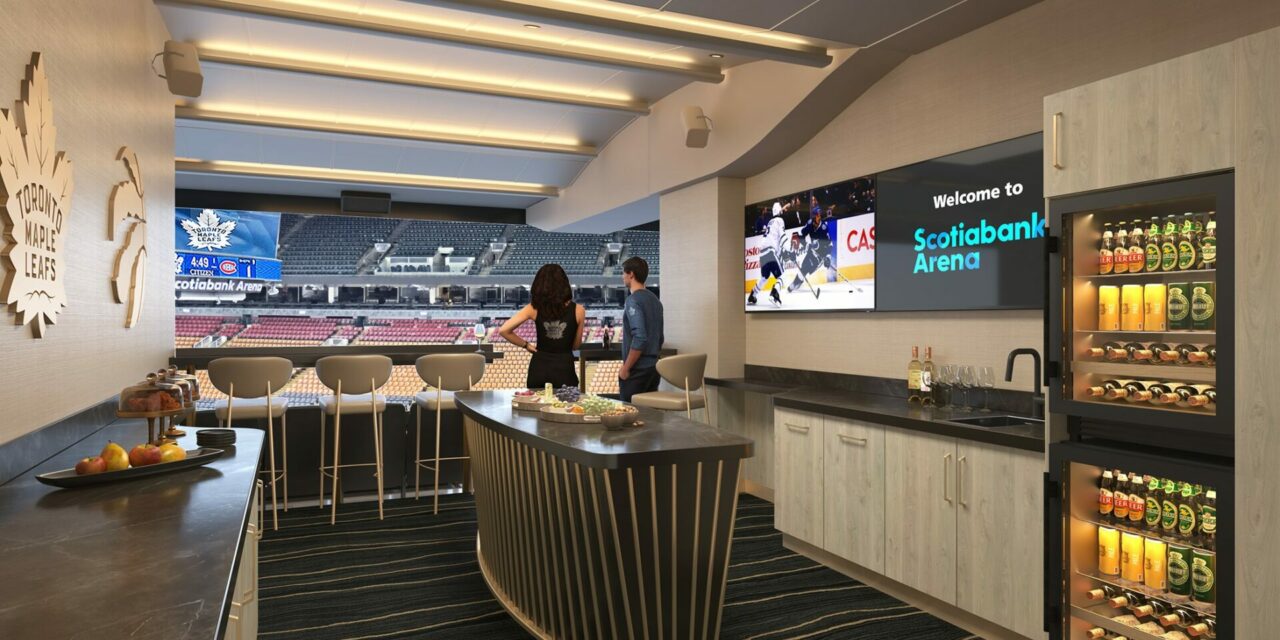SUITE VIEW: Scotiabank Arena had 43 traditional suites rebuilt with higher ceilings to provide better views to the arena bowl as part of a $350 million makeover. (All images courtesy MLSE)
Arena’s first all-inclusive club debuts
Scotiabank Arena has completed the first piece of an extensive $350 million renovation of the Toronto facility that turns 25 years old in February, the centerpiece of which is the new Mastercard Lounge.
Four years after Maple Leaf Sports and Entertainment, which owns the Toronto arena and its tenants, the Toronto Maple Leafs and Raptors , formed a master plan for upgrading the 19,800-seat venue, the first phase of a multiyear project opened last week for preseason hockey and two concerts by Drake, the Raptors’ goodwill ambassador.
“Our owners were supportive of a renovation strategy as we were building it out in 2019, leading into 2020 when COVID hit,” said Nick Eaves, Maple Leaf Sports’ chief venues and operations officer. “We went into operational survival mode and put that big ambition on hold for a few years. To our owners’ credit, early in our emergence from COVID, they remained committed to that strategy.”
Scotiabank Arena’s project falls in line with many other big league arenas built in the 1990s that have undergone nine-figure renovations over the past decade, including most recently, Wells Fargo Center and Gainbridge Fieldhouse, both of which topped $350 million.

In Toronto, MLSE hired Canadian firms Brisbin Brook Beynon and PCL Construction, the arena’s original architect and builder, to reprise their roles for the renovation. CAA Icon, headquartered in Denver, Colorado, is the owner’s representative. Sports & the Arts, based in Southern California, helped curate the arena’s new arena art program that’s part of phase one, showcasing 34 artists and a total of 76 pieces of art.
On its own, BBB has designed major renovations to Wells Fargo Center, TD Garden and Madison Square Garden. Since Scotiabank Arena opened in 1999, originally named Air Canada Centre, the firm has designed a new variable rise seating system, a refresh of the Raptors’ locker room and helped Maple Leaf Sports implement new safety protocols when the building reopened in February 2022 after the pandemic.
The first phase of what could ultimately turn into a five-phase project to bring one of the world’s busiest arenas up to date focused on creating new premium spaces and rebuilding existing suites across the 200 level.
The Mastercard Lounge, a 2,800-square-foot space, was formed by consolidating 15 suites into an all-inclusive club. The 205-seat club, branded for Mastercard, an existing arena sponsor, is situated in the arena’s southwest corner by Gate 5B.

MASTER CLASS: The new Mastercard Lounge, shown in a rendering, opens for the NBA and NHL seasons.
As part of developing the new club, Mastercard, which has sponsored the entire suite level, renewed its agreement covering several components and added the lounge as another asset, Eaves said.
The club seats in the bowl are supported by a lounge and dining space. It’s MLSE’s first all-inclusive product, with the cost of food and drink included in the membership fee.
Alcohol is excluded per Ontario law and must be purchased separately, Eaves said.
Hockey, basketball games and concerts are included in the fee. Demand has been “phenomenal,” Eaves said, but officials would not disclose the membership fee because the marketing team is still working through final details of the program.
Because the club sits behind the stage on the west side, for most concerts, those patrons get first access to seats elsewhere in the seating bowl for those events. For concerts in the round, such as Drake, they have first right to club seats that aren’t obstructed view, Eaves said.
In addition, MLSE revamped 43 traditional suites with new vaulted ceilings that provide better views of the event floor, coupled with new technology for ordering food, drink and merchandise.
“The greatest effect is that your view from the suite into the arena is much more open and dramatic,” Eaves said. “When the arena was built, it was just a flat, drywall ceiling, which was nice, but we discovered there was a bunch of space above it that had a few services, but stuff we could relocate.”
DreamSeat, the same vendor producing seating for the Intuit Dome opening next year for the Los Angeles Clippers, produced new cushioned seats for Scotiabank Arena suites and the Mastercard Lounge.
“Their product is spectacular,” Eaves said. “They’re beautiful seats with a higher back and a bit wider.”
Providing greater accessibility for physically disabled fans has been a key driver for all improvements, which extends to suite seats that can be transitioned for wheelchair-bound individuals, said Michelle Pavone, project director for Brisbin Brook Beynon. That wasn’t the case before the retrofit, Pavone said.
“It’s a building with a lot of concerts, hockey and basketball games, so it’s a matter of getting everybody on the same page by making sure all the spaces are flexible, because they’re being used for three to four different types of activities on any given day,” Pavone said. “That part has been an interesting design challenge.”

GO TORONTO: More grab-and-go markets are coming in future phases.
The other portion of phase one is tied to opening two new grab-and-go markets using Amazon Just Walk Out technology on the 100 and 300 level, which are the lower and upper concourses. A half-dozen more JWO locations are planned as part of a mix of grab-and-gos using self-checkout kiosks. Some belly-up concession stands will remain in place.
“We’ve done enough research to know that like in most markets, our fans will respond well to that type of technology and ease of service that comes with that sort of frictionless experience,” Eaves said.
Maple Leaf Sports went with Amazon over Zippin, which is in place at Rogers Centre, home of MLB’s Toronto Blue Jays, and where Aramark runs the food service. At Scotiabank Arena, where the food is run in-house, the decision was due to Amazon’s existing partnership in SportsX, MLSE’s digital innovation lab.
“We got comfortable with AWS technology and have worked with Amazon on a bunch of different things,” Eaves said. “It’s the right one for us due to the partnership and how we’ve seen it work at other arenas.”
Next summer, phase two will focus on overhauling the 100 level, where 80% of ticket holders come through the gates.

TEAM UP: A second team store, measuring 2,300 square feet, is planned for Scotiabank Arena.
Over time, the main concourse became a mishmash of food, drink and merchandise kiosks and the goal is to expand concessions technology in greater detail with a more uniform look. For the most part, though, the 100 level has gone untouched since 1999, Eaves said.
“We’re going to add a new team store at Gate 1 where one didn’t exist and we’re renovating the existing one,” he said. “We had the smallest retail footprint of any NBA and NHL arena. It wasn’t prioritized when we built the facility. We will have enough space to showcase merchandise for all of our teams, including (Major League Soccer’s) Toronto FC and the (CFL’s) Argonauts.”
A new tunnel club at event level, remaking the Hot Stove restaurant on the 200 level and redesigning the Gate 6 broadcast studio to improve the viewing experience for fans watching the Leafs and Raptors at home are other projects in the future.
“We’re routinely among the top five busiest arenas in North America and top 10 to 12 busiest in the world, and it’s our duty to fans, players, artists and employees to make sure this building continues to be among the best and keeps getting better,” Eaves said.







